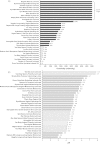Treating vulvovaginal atrophy/genitourinary syndrome of menopause: how important is vaginal lubricant and moisturizer composition?
- PMID: 26707589
- PMCID: PMC4819835
- DOI: 10.3109/13697137.2015.1124259
Treating vulvovaginal atrophy/genitourinary syndrome of menopause: how important is vaginal lubricant and moisturizer composition?
Abstract
Vaginal dryness is a common condition that is particularly prevalent during and after the menopause, and is one of the symptoms of vulvovaginal atrophy/genitourinary syndrome of menopause. The impact of vaginal dryness on interpersonal relationships, quality of life, daily activities, and sexual function can be significant, but is frequently underestimated. Furthermore, barriers exist to treatment-seeking, and this condition is often underreported and undertreated. Greater education about vaginal dryness and the range of available treatments is essential to encourage more women to seek help for this condition. Personal lubricants and moisturizers are effective at relieving discomfort and pain during sexual intercourse for women with mild to moderate vaginal dryness, particularly those who have a genuine contraindication to estrogen, or who choose not to use estrogen. However, there is a distinction between lubricants and moisturizers, and notable differences between commercially available products. Women should be advised to choose a product that is optimally balanced in terms of both osmolality and pH, and is physiologically most similar to natural vaginal secretions. A series of recommendations for the use of vaginal lubricants and moisturizers, either on their own or in combination with systemic or topical hormone replacement therapy, is presented.
Keywords: Cytotoxicity; genitourinary syndrome of menopause; lubricant; moisturizer; osmolality; vaginal dryness; vulvovaginal atrophy.
Figures

Similar articles
-
Vaginal lubricants and moisturizers: a review into use, efficacy, and safety.Climacteric. 2021 Feb;24(1):19-24. doi: 10.1080/13697137.2020.1820478. Epub 2020 Sep 29. Climacteric. 2021. PMID: 32990054 Review.
-
Treatment of the genitourinary syndrome of menopause.Climacteric. 2015;18 Suppl 1:23-9. doi: 10.3109/13697137.2015.1079100. Climacteric. 2015. PMID: 26366797 Review.
-
What's new in the world of postmenopausal sex?Curr Opin Obstet Gynecol. 2016 Oct;28(5):449-54. doi: 10.1097/GCO.0000000000000311. Curr Opin Obstet Gynecol. 2016. PMID: 27517339 Review.
-
Non-hormonal topical treatment of vulvovaginal atrophy: an up-to-date overview.Climacteric. 2013 Jun;16(3):305-12. doi: 10.3109/13697137.2012.756466. Epub 2013 Jan 8. Climacteric. 2013. PMID: 23215675
-
Efficacy of intravaginal dehydroepiandrosterone (DHEA) on moderate to severe dyspareunia and vaginal dryness, symptoms of vulvovaginal atrophy, and of the genitourinary syndrome of menopause.Menopause. 2018 Nov;25(11):1339-1353. doi: 10.1097/GME.0000000000001238. Menopause. 2018. PMID: 30358731 Clinical Trial.
Cited by
-
Modern approach to the management of genitourinary syndrome in women with gynecological malignancies.Radiol Oncol. 2023 Jul 26;57(3):292-298. doi: 10.2478/raon-2023-0038. eCollection 2023 Sep 1. Radiol Oncol. 2023. PMID: 37494601 Free PMC article. Review.
-
Management of radiation therapy-induced vaginal adhesions and stenosis: A New Zealand survey of current practice.J Med Radiat Sci. 2020 Jun;67(2):128-133. doi: 10.1002/jmrs.386. Epub 2020 Apr 8. J Med Radiat Sci. 2020. PMID: 32267099 Free PMC article.
-
Bacterial vaginosis incidence following a single hyperosmolal vaginal lubricant exposure: A comparison of two observational cohorts.Sex Transm Dis. 2025 May 26:10.1097/OLQ.0000000000002184. doi: 10.1097/OLQ.0000000000002184. Online ahead of print. Sex Transm Dis. 2025. PMID: 40417982
-
Stable Ozonides plus Vitamin E Acetate (Ozoile) for Treatment of Genitourinary Syndrome.Medicina (Kaunas). 2024 May 27;60(6):880. doi: 10.3390/medicina60060880. Medicina (Kaunas). 2024. PMID: 38929497 Free PMC article.
-
Management of genitourinary syndrome of menopause in breast cancer survivors: An update.World J Clin Oncol. 2022 Feb 24;13(2):71-100. doi: 10.5306/wjco.v13.i2.71. World J Clin Oncol. 2022. PMID: 35316932 Free PMC article. Review.
References
-
- Dunn KM, Croft PR, Hackett GI. Sexual problems: a study of the prevalence and need for health care in the general population. Fam Pract. 1998;15:519–24. - PubMed
-
- Leiblum SR, Hayes RD, Wanser RA, Nelson JS. Vaginal dryness: a comparison of prevalence and interventions in 11 countries. J Sex Med. 2009;6:2425–33. - PubMed
-
- Palacios S. Managing urogenital atrophy. Maturitas. 2009;63:315–18. - PubMed
-
- Panay N, Fenton A. Vulvovaginal atrophy – a tale of neglect. Climacteric. 2014;17:1–2. - PubMed
-
- Portman DJ, Gass ML, Vulvovaginal Atrophy Terminology Consensus Conference Panel Genitourinary syndrome of menopause: new terminology for vulvovaginal atrophy from the International Society for the Study of Women's Sexual Health and The North American Menopause Society. Climacteric. 2014;17:557–63. - PubMed
Publication types
MeSH terms
Substances
LinkOut - more resources
Full Text Sources
Other Literature Sources
Medical
Molecular Biology Databases
